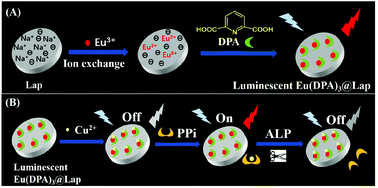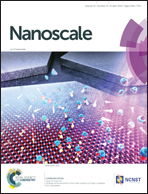A luminescent europium-dipicolinic acid nanohybrid for the rapid and selective sensing of pyrophosphate and alkaline phosphatase activity†
Abstract
As a ubiquitous hydrolysis enzyme in phosphate metabolism, alkaline phosphatase (ALP) is a significant biomarker in laboratory research and clinic diagnosis. Herein, we report a highly water-soluble Eu(DPA)3@Lap nanohybrid material for the rapid and selective assay of PPi and ALP through a luminescence off–on recognition process. Eu(DPA)3@Lap was successfully prepared in an aqueous solution, and it exhibited strong luminescence emission, high photostability, and long lifetime. More interestingly, the strong luminescence of Eu(DPA)3@Lap can be remarkably quenched by Cu2+ due to the high impetus of coordination between the DPA ligand and Cu2+ ion. Using Cu2+ as a signal transducer, the luminescence could be recovered upon the addition of PPi ion owing to the formation of a Cu2+–PPi complex; thus, a luminescence turn-on assay for PPi ions was realized. Utilizing the ability of Cu2+ to differentiate between PPi and Pi, a convenient and straightforward luminescence assay for ALP activity was accomplished based on the specific dephosphorylation of PPi to Pi. To the best of our knowledge, this elaborate luminescence sensing system constitutes the first luminescent nanohybrid material based on a europium organic complex for ALP activity assay. Furthermore, the recognition process of PPi and ALP was completed in a convenient and facile mix-and-readout manner, and it revealed significant potential in point of care testing.



 Please wait while we load your content...
Please wait while we load your content...